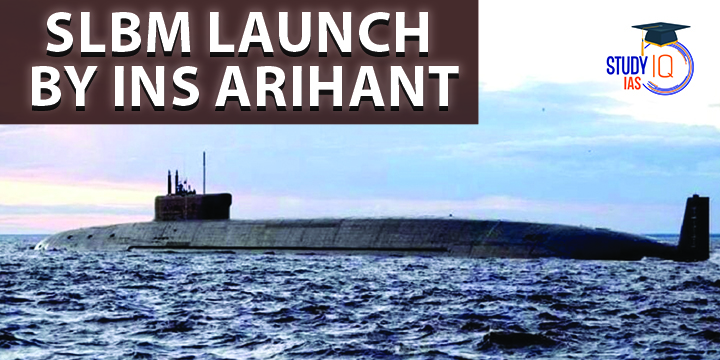Table of Contents
Submarine Launched Ballistic Missiles SLBM
Submarine Launched Ballistic Missiles is a family of indigenously developed Submarine Missiles. They are also referred to as K-family missiles, codenamed after Dr APJ Abdul Kalam.
Features: Since Submarine Launched Ballistic Missiles SLBM are to be launched from submarines, they are lighter, more compact and stealthier than their land-based counterparts (Agni series).
Under SLBM, missiles of various ranges have been developed including K-15 also called Sagarika. It has a range of at least 750 km.
India has also developed and tested the K-4 missiles from the same family, having a range of 3,500 km.
More members of the K-family, code named K-5 and K-6, with a range of 5,000 km and 6,000 km respectively — are currently under development.
Submarine Launched Ballistic Missiles: INS Arihant
INS Arihant is India’s nuclear-powered ballistic missile capable submarine and was commissioned in 2016.
INS Arihant and its class of submarines are classified as ‘SSBN’, which represents the hull classification symbol for nuclear powered ballistic missile carrying submarines.
Construction: It was the first of the planned five in the class of submarines designed and constructed as a part of Advanced Technology Vessel (ATV) project of Indian Navy.
Operations: Even though the Indian Navy operates the vessel, the operations of the SLBMs from the SSBN come under the control of India’s Strategic Forces Command, which is part of India’s Nuclear Command Authority.
Technology: The Arihant class submarines are reported to be based on the Akula-class submarine of Russian Navy. It is powered by an 83 MW pressurized light-water reactor with enriched uranium fuel.
Significance: India is among a handful of countries that can design, construct and operate Strategic Strike Nuclear Submarines (SSBN).
Submarine Launched Ballistic Missiles Latest News
The launch of the SLBM by INS Arihant is significant to prove crew competency and validate India’s nuclear deterrence capability.
A robust, survivable and assured retaliatory capability will uphold India’s policy to have ‘Credible Minimum Deterrence’.
Nuclear retaliatory attacks can only be allowed by the civilian political leadership through the Nuclear Command Authority.
Submarine Launched Ballistic Missiles: India’s Nuclear Policy
India’s nuclear policy is based on the tenets of ‘credible minimum deterrence’ and ‘no first use’. They are vital to India’s nuclear doctrine.
Nuclear weapons will only be deployed in retaliation against a nuclear attack on Indian Territory or on Indian forces anywhere; and the retaliation to a first strike will be massive and designed to “inflict unacceptable damage”.
Submarine Launched Ballistic Missiles Importance
Nuclear triad: The capability of being able to launch nuclear weapons from submarine platforms has given India strategic significance in the context of achieving a nuclear triad.
Nuclear Triadmeans the capability of a country to deliver nuclear weapons by aircraft, land based ballistic missiles and submarine launched missiles.
Nuclear deterrence: In context of “No First Use” policy, sea-based underwater nuclear capable assets significantly increases the second strike capability.
Submarines can not only survive first strike but can also launch a strike in retaliation, thus achieving ‘Credible Nuclear Deterrence’.
Protection of territory: Nuclear submarines can stay underwater for a longer period without having to surface. This is significant considering the necessity of monitoring a large territory.


 Question Hour in Parliament: Meaning, Ty...
Question Hour in Parliament: Meaning, Ty...
 Daily Quiz 18 July 2025
Daily Quiz 18 July 2025





















